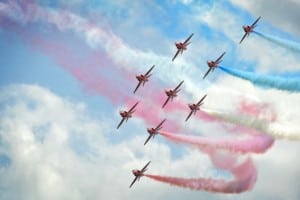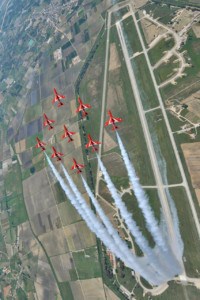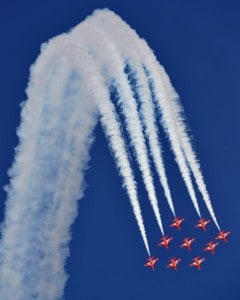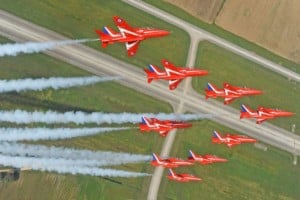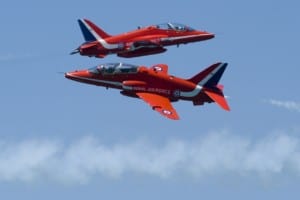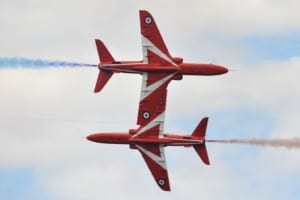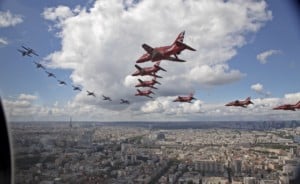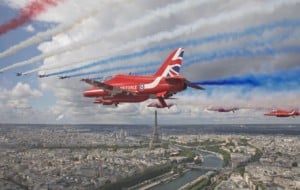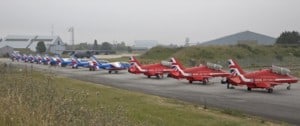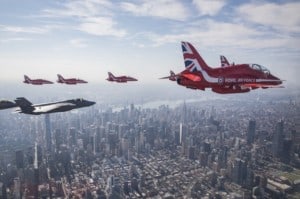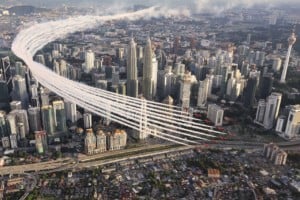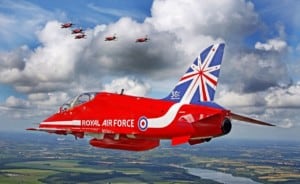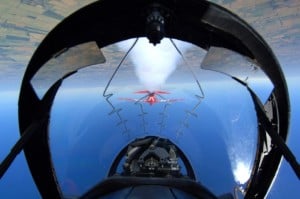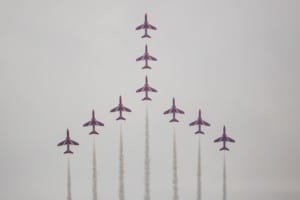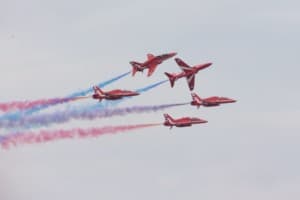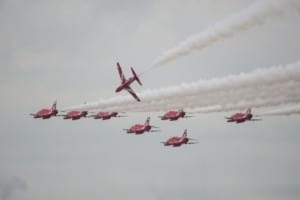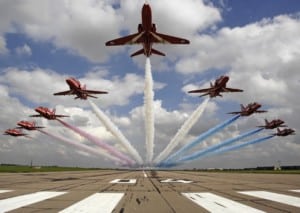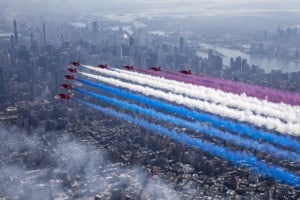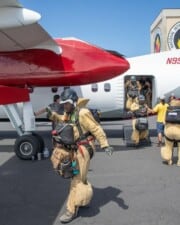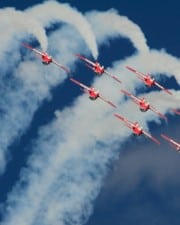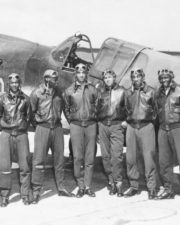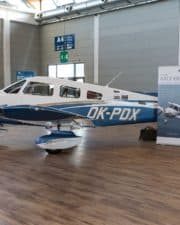Few things capture the imagination of aviation lovers quite like aerobatic teams. The United States has the Blue Angels, and the United Kingdom has the Red Arrows, but where did this British band of aerobatic daredevils come from?
Table of Contents
From Henry V’s legendary longbow men to Robin Hood to the Powell/Pressberger “Archers” filmmaking duo, archery symbolism has long been big in Britain, and the Red Arrows are another example. Like Robin Hood’s legends, the Red Arrows’ colorful history comes from many sources and looms large in British cultural consciousness.
For other aerobatics teams see:
1. The Red Arrows’ Start
If you’ve come here wondering “What are the Red Arrows?” you’ll quickly find that they’re both a world-class aerobatics team and much more.
If you’re wondering “When were the Red Arrows formed?” and “When did the Red Arrows start?” we first need to look at how and why they were created – and that means looking at what came before them.
British aerobatic teams go back a century to the first stunt squadrons coming into existence after the First World War.
An RAF aerial pageant took place in 1920, while 1925 saw a six-night long show called “London Defended” at the British Empire Exhibition. This performance featured Sopwith Snipes painted red flying amidst blank ammunition and pyrotechnics.
The display also featured Flying Officer C.W.A. Scott, who would later go on to break three solo aviation records for Britain-to-Australia flights.
The same year as the “London Defended” exhibition saw Virginia Woolf publish her seminal masterpiece Mrs. Dalloway, which features a skywriter plane creating an ambiguous slogan in the skies above London that people try to decipher.
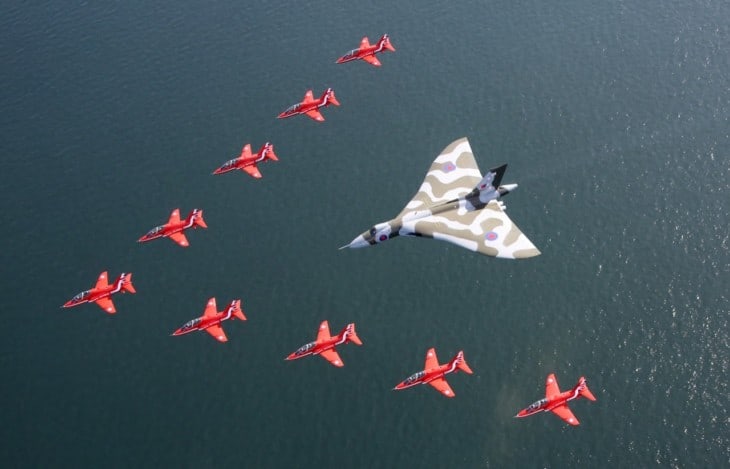
The next decades would bring various new configurations of flight teams and plane models.
The year 1947 saw the first de Havilland Vampires used for flight shows. RAF No. 72 Squadron flew Vampires in 1950, No. 54 Squadron performed the first RAF show with smoke tails and later received Gloster Meteors in 1955, with that same year seeing No. 66 Squadron fly Hawker Hunters.
The year 1956 saw the first official RAF aerial team be formed, with pilots taken from No. 111 Squadron and the team using fighters painted with an all-black finish. After a show in France, they earned the nickname “Les Fleches Noires” – the Black Arrows.
This crew was the first team to fly in formations of five Hunters, and by 1958 the team was pulling off loop and barrel roll maneuvers with 22 Hunters, a world record for the most aircraft in a looped formation.
In 1961, the Blue Diamonds of No. 92 Squadron took over the role, flying 16 Hunters painted blue, while 1964 saw the Red Pelicans – a team of six BAC Jet Provost T Mk 4s – take over the role as the premiere RAF display team.
Several other flight teams existed until they were all amalgamated later that year, giving rise to the “Red Arrows,” with the name coming from a combination of the Red Pelicans and Black Arrows.
2. The History of the Red Arrows
The squadron’s golden years came in the 1950s and 60s when, as described above, they and their predecessors were breaking records and wowing crowds the world over. The newly-christened Red Arrows first performed at RAF Little Rissington on May 8, 1965.
Still, Little Rissington is just the first of many answers to the perpetually changing question “Where are the Red Arrows based?” If you’re wondering “What planes do the Red Arrows use?” that answer has changed over the years, too.
The team was initially equipped with seven Follant Gnat trainer jets, which were inherited from a previous RAF display team, the Yellowjacks. In their first season, the Red Arrows performed at 65 shows throughout Europe.
These standout performances in 1965 were so impressive that they won the Red Arrows the Britannia Trophy for aviation excellence.
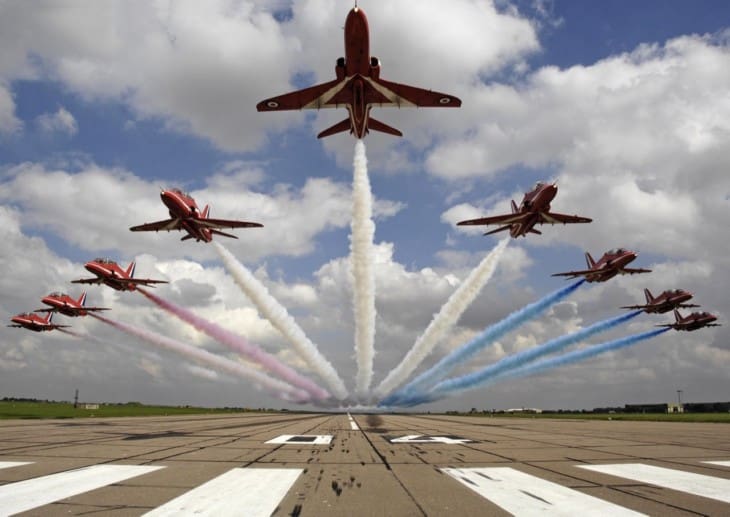
The Red Arrows (officially known as the Royal Air Force Aerobatic Team) were first based at RAF Little Rissington, located in Gloucestershire, before moving on to the Central Flying School and then RAF Kemble, which is now Cotswold Airport, in 1966.
The team increased to nine pilots and jets in 1966, with the first nine-plane performance occurring on July 8 for HRH the Duke of Edinburgh.
However, the team didn’t “officially” increase to nine planes until 1968. This policy of keeping alternates changed when it was realized that the maneuvers were so specialized and each position in the formation so demanding they required full-time attention, and spare pilots were naturally dissatisfied by their roles.
Still, the extra fighter jets and pilots proved a blessing, as it allowed the team to develop their signature Diamond Nine formation.
The first Red Arrows team was led by Lee Jones, with Ray Hanna commanding in 1968 when the team formally expanded and served again after Timothy Lenson served for the 1969 season.
Hanna’s four seasons as leader is a record that still stands, and his service to the team and RAF was honored with an additional bar to his Air Force Cross.
In 1979, the team switched from their Follant Gnats to BAE Hawk trainers. The Hawks feature a special engine modification that allows them to spew their trademark smoke trails.
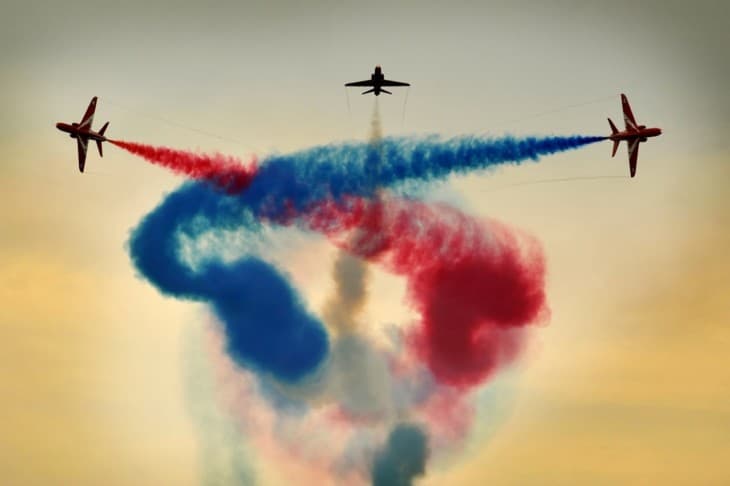
Another move came in 1983, the CFS headquarters moved to RAF Scampton. The Red Arrows followed and were based there until 1995 when, as a cost-saving measure, Scampton was closed down, and the team was moved to RAF Cranwell despite still using Scampton’s air space.
The Red Arrows formally moved back to their Scampton home in 2000.
Still, trouble loomed on the horizon, as in July 2004 reports surfaced that the Red Arrows were to be disbanded following a review of defense spending that found them to operate at a cost of £5 to £6 million, a hard figure to justify in terms of publicly-funded support.
However, the Red Arrows pulled off yet another death-defying maneuver in avoiding the chopping block. Their existence was justified as a way to promote RAF recruitment while offering good PR for the defense industry and military.
Additionally, the Red Arrows have come to gain national symbolic significance. A 2004 BBC story on the potential axing quoted Nick Cook, a defense journalist, as saying that the Red Arrows were an “internationally recognised symbol of Britain and the British aerospace industry.”
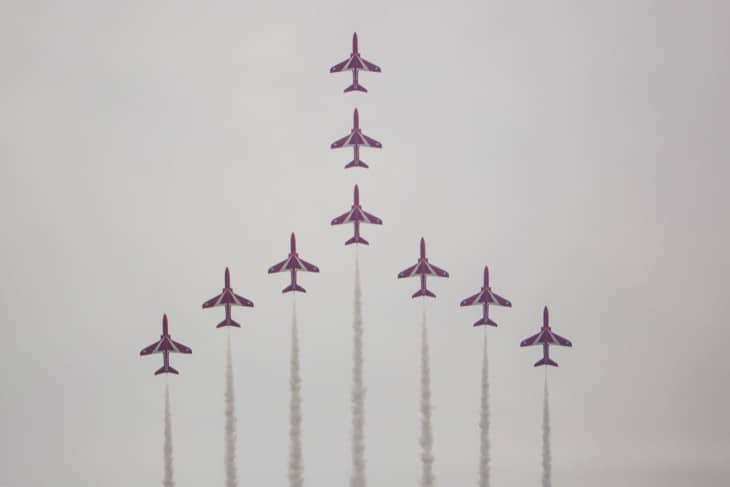
Further demonstrating that reports of their demise were very much exaggerated, the team put on their 4000th aerial display in September 2006 at the Royal Air Force Leuchars’ Battle of Britain Airshow.
Then-Prime Minister David Cameron said the team was “safe” under his government in 2013, when the team was operating at a cost of £9 million.
That said, if you’re wondering “How much do Red Arrows pilots get paid?” thinking that they’re raking in the pounds, while the answer can be hard to gauge, guesses typically range around £44,000.
While that cost is steep (especially at a time when essential British services such as the NHS are underfunded and under attack), there is a case to be made that the Red Arrows are worth the cost in the revenue they earn back.
For example, in September 2008, the UK charity Help for Heroes reported that a bidder, Julie Heselden, donated £1.5 million to fly in the team’s famous red jets, so if you’re wondering “How much does it cost to hire the Red Arrows?” get ready to write a big check.

Even more dramatically, a nine-week tour of the United States and Canada in 2018 – the team’s first North American excursion in more than a decade – was expected to garner £2.5 billion.
That said, the question of “Where do the Red Arrows practice?” has a further wrinkle to it as the team will still use the airspace above Scampton for training.
3. Crashes and Incidents
Unfortunately, 2018 also saw tragedy strike the Red Arrows as a Hawk jet crashed at RAF Valley in Wales. The pilot, Flight Lt. David Stark, was able to eject before crashing, but an engineer on the ground, Corporal Jonathan Bayliss, was killed.
An inquiry found that, at the time of the crash, Stark was said to be “fatigued” and “distracted” having worked from 07:30 until 17:30, with the report concluding that he did not take “sufficient time for rest.”
Stark had only a 0.5 to 2.5 seconds to eject and was thus unable to warn Bayliss.
This was far from the only incident in the Red Arrows’ history. Over the decades, there have been several near-misses, crashes, and safety issues, including:
- A Gnat hitting the trees and two Gnats crashing in 1969
- Two Gnats colling in 1971, resulting in four fatalities, and a later crash that year resulting in one further fatality
- A Gnat striking a cable in 1976
- A Gnat striking the ground during rollback maneuvers in 1978, with the pilot, Stephen Edward Noble, dying of his injuries
- A Gnat experiencing fuel blockage in 1979, resulting in the pilot ejecting
- A Hawk hitting a yacht mast while performing at an air show in Brighton in 1980, leading to an ejection
- A Hawk hitting the ground while practicing a loop in Cyprus in 1984, resulting in serious injuries to the pilot
- Later on, in 1984, a Hawk crashed into the sea three miles off the coast of Devon due to engine failure, with a rescue boat saving the pilot
- Two Hawks collided in 1987, and both pilots safely ejected, though one was forced to leave the team
- A Hawk crashed while attempting a rollback in 1988, killing the pilot, Neil Duncan MacLachlan
- A Hawk overshot the runway at Jersey Airport in 1998, running onto a gravel pile without sustaining significant damage
- Two Hawks again collided in 2010 during a training session in Crete, with one pilot able to land his plane and the other sustaining injuries following ejection
- A Hawk crashed a mile away from Bournemouth Airport in 2011, killing the pilot, Jon Egging
- Tragedy struck again in 2011 as another pilot, Sean Cunningham, was ejected from his jet while it was still on the ground at RAF Scampton, killing him when his parachute failed to open; the seat manufacturer, Martin-Baker, was prosecuted and pled guilty to breaching safety regulations
The 2018 Red Arrows crash wasn’t the only unfortunate thing to happen to the team that year, as it was announced that the RAF Scampton site would close as well, with 2022 being the timetable given.
4. Speed and Fuel
Despite the Nine Diamonds formation name, the current answer to the question “How many Red Arrows are there?” is 11 (9 jets and 11 pilots) with each member of the team working to pull off amazing stunts.
How fast do the Red Arrows fly? Their Hawks can reach speeds of 645 mph with a top speed of Mach 1.2.
As for the famous Red, White, and Blue smoke trails created by the Red Arrows, this is a result of the jets releasing diesel into their exhaust, which causes it to immediately oxidize.

The diesel itself is stored in pods beneath the plane, which contains three tanks – one of 230 L pure diesel and two 45 L tanks with blue and red-dyed diesel. This is about enough for one minute of red and blue smoke each and seven minutes of white smoke.
5. The UK Red Arrows Versus the US Blue Angels
It’s a matchup for flight geeks everywhere – Red Arrows vs. Blue Angels. The teams have performed together in the past, and remain two of the best-known aerobatic squads the world over.
A quick comparison of the team shows that there are 11 Red Arrows versus 16 Blue Angels, and while the Blue Angels are older (1946) the Red Arrows, as mentioned, have earlier predecessors.
If you’re wondering “How do the Red Arrows get to America?” the answer is that they will make the journey over three days and several stops, as the planes don’t have sufficient range to make the transatlantic crossing at once. They fly via Scotland, Iceland and Greenland to Halifax, Canada.
The 2019 tour saw the Red Angels touch down in the United States and Canada for more than 20 displays as well as 98 distinct ground engagements.
RAF Red Arrows Photo Gallery
Below is a large photo gallery of RAF Red Arrow images. Click on any photo to enlarge and scroll through the gallery.
Break RAF Red Arrows Close Up RAF Red Arrows Colour on RAF Red Arrows Line astern RAF Red Arrows Looping RAF Red Arrows Over The Top RAF Red Arrows Rolling Left RAF Red Arrows Synchro Pass RAF Red Arrows Synchronised RAF Red Arrows A Red Arrows Hawk in the skies above Paris to mark the 80th anniversary of a speech by Charles de Gaulle one of the Red Arrows pilots and an Engineer passenger preparing for take off. Red Arrows and the French Patrouille De France in the skies above Paris Red Arrows flying over southern Jordan Red Arrows visiting RAF Brize Norton as they transit to conduct a flypast over London The Red Arrows and the French Patrouille De France in the skies above Paris The Red Arrows and the French Patrouille De France on the ground in France The Red Arrows complete the RAF100 Flypast over Buckingham Palace The Red Arrows fly over the Golden Gate Bridge San Francisco The Red Arrows flying above New York City the Red Arrows performing a display over the Petronas Towers Kuala Lumpur Red 6 of the world famous air display team the Red Arrows is pictured during a transit flight from Denmark back to the UK Pilots view from within the cockpit of a Red Arrow The Red Arrows at Armed Forces Day National Event Held in Cleethorpes in 2016 1 The Red Arrows at Armed Forces Day National Event Held in Cleethorpes in 2016 2 The Red Arrows at Armed Forces Day National Event Held in Cleethorpes in 2016 3 The Red Arrows at Armed Forces Day National Event Held in Cleethorpes in 2016 4 The Red Arrows have flown with the Vulcan bomber for the final time in a show of great British aviation icons The Red Arrows performing a low level flypast over 04 threshold at RAF Scampton The Royal Air Force Aerobatic Team The Red Arrows fly over New York
Related Posts




